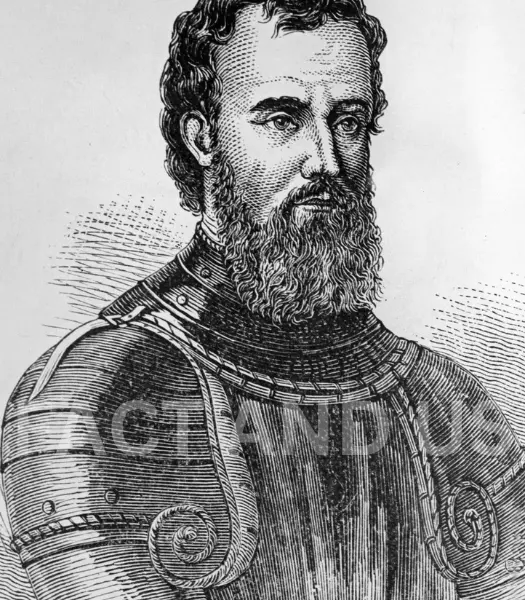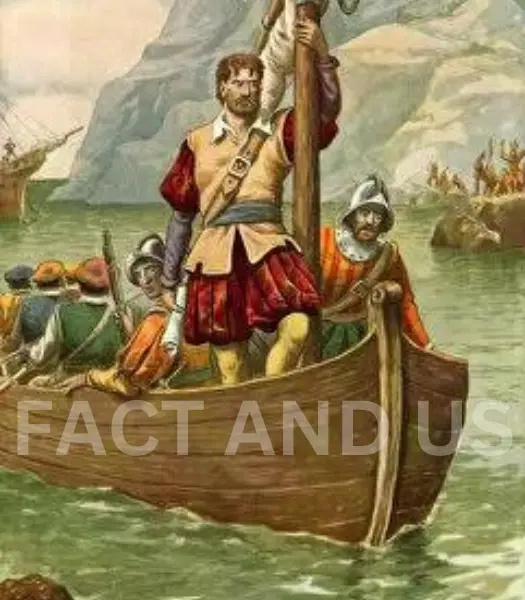Giovanni da Verrazzano (born 1485, Tuscany [Italy]—died 1528, Lesser Antilles) was an Italian navigator and explorer for France who was the first European to sight New York and Narragansett bays. After his education in Florence, Verrazzano moved to Dieppe, France, and entered that nation’s maritime service. He made several voyages to the Levant, and in 1523 he secured two ships for a voyage backed by the French king to discover a westward passage to Asia. In January 1524 he sailed one of those vessels, La Dauphine, to the New World and reached Cape Fear about the beginning of March. Verrazzano then sailed northward, exploring the eastern coast of North America. He made several discoveries on the voyage, including the sites of present-day New York Harbor, Block Island, and Narragansett Bay, and was the first European explorer to name newly discovered North American sites after persons and places in the Old World.

Contents
Giovanni da Verrazzano
Verrazzano wrote interesting, though sometimes inaccurate, accounts of the lands and inhabitants that he encountered. His explorations concluded at the eastern part of Newfoundland. His return to France on July 8, 1524, gave King Francis I his nation’s claim to the New World. Verrazzano undertook two more voyages to the Americas. In 1527 he commanded a fleet of ships on an expedition to Brazil that returned profitable dyewood to France. His final voyage began in the spring of 1528, when he sailed with his brother, Girolamo, from Dieppe with two or three ships. The fleet sailed to Florida, the Bahamas, and finally the Lesser Antilles. He anchored there off one of the islands (apparently Guadeloupe), went ashore, and was captured, killed, and eaten by cannibals.
Early Life
Giovanni da Verrazzano (also spelled Verrazano) was born in 1485. Not much about his early life is known, and the exact location of his birth is unsure. But many historians believe he was born in Tuscany, Italy. He was the son of Piero Andrea de Bernardo da Verrazzano and Fiammetta Cappelli. He received a good education in Florence, Italy, and then around 1506, he moved to Dieppe, France. Here he joined the maritime service, and began his seafaring career as a navigator on French merchant ships in the Mediterranean. He made several voyages to the Levant, the land at the eastern end of the Mediterranean Sea. Verrazzano would gain the skills needed to command a voyage of his own. During this period, France and Spain were constantly at war with each other. Verrazzano was took part in some privateering, or piracy, against Spanish ships at the French king’s request.

In 1523, Verrazzano was commissioned by King Francis I of France to discover a passage to Asia through the New World. The King of France was interested in finding a direct sea route to the Pacific Ocean. By this time, the Portuguese had a dominance over much of the eastern sea routes to China. The Spanish were exploring and exploiting South America and the Caribbean. Verrazzano suggested to the king that he could find a more direct route to the Pacific by way of a Northwest Passage. The king wanted Verrazzano to explore the eastern coast of the New World from Florida up to Newfoundland to find this route. Verrazzano was financed by a group of French merchants and Italian bankers in Lyons, France. With money and the king’s blessing, Giovanni da Verrazzano sailed from Dieppe, France in late 1523. He started with four ships: La Dauphine, Santa Maria, La Normande, and Vittoria. However, shortly after departing they were caught in a storm. Two ships, the Santa Maria and Vittoria, were lost in the storm. The La Normande was damaged beyond repair, leaving only La Dauphine seaworthy for Verrazzano’s voyage.
Biografia
Nacque intorno al 1485 dalla famiglia proprietaria dell’omonimo castello in val di Greve. Secondo la tradizione più accreditata, i suoi genitori furono Pier Andrea di Bernardo e Fiammetta Barone[2]. Nonostante da Verrazzano abbia lasciato una descrizione dettagliata dei suoi viaggi nel Nord America, poco sappiamo della sua vita. Raggiunta la maggiore età (intorno al 1506–1507) scelse la carriera di navigatore e per questo si trasferì in Normandia.
Viaggi
Effettuò numerosi viaggi nel Mar Mediterraneo orientale e, nel 1523, fu inviato dal re di Francia Francesco I ad esplorare una zona tra la Florida e Terranova per cercare una nuova rotta per l’Oceano Pacifico. Partito da Dieppe, costeggiò il litorale spagnolo e attraversò l’Atlantico a bordo di una piccola caravella con una cinquantina di uomini.Si avvicinò alla costa vicino a Cape Fear intorno al 1º marzo 1524 e, dopo una breve sosta, continuò a risalire lungo la costa in direzione nord, al largo dell’odierna Carolina del Nord e della laguna di Pamlico Sound, che descrisse nella sua lettera a Francesco I come una grande insenatura che pensava fosse l’inizio dell’Oceano Pacifico, da cui accedere direttamente alle coste della Cina. Scrisse che l’istmo era largo circa un miglio. Questa annotazione fu all’origine di una duratura tradizione cartografica errata, che durò fino al XVIII secolo, incominciando dalle carte di Vesconte Maggiolo nel 1527 e con Girolamo da Verrazzano (fratello di Giovanni) nel 1529, che vedevano il continente americano diviso in due parti, unite da un piccolissimo istmo sulla costa atlantica.
Giovanni da Verrazzano fece numerosi scali durante la sua esplorazione, entrando in contatto con i nativi americani della costa. Continuando la navigazione, passò oltre la baia di Chesapeake e il fiume Delaware. Successivamente arrivò alla baia di New York e gettò l’ancora in The Narrows, lo stretto fra Staten Island e Long Island, dove ricevette un gruppo di canoe dei nativi Lenape. Qui osservò quello che credeva essere un grande lago di acqua dolce a nord della baia, senza però riscontrare l’esistenza del fiume Hudson.Proseguendo il suo viaggio verso nord, da Verrazzano costeggiò Long Island, attraversò il Block Island Sound ed entrò nella baia di Narragansett,dove probabilmente incontrò il popolo Narragansett. Seguì poi la costa verso nord nell’odierno Maine e nella Nuova Scozia sudorientale, per poi rientrare in Francia passando per Terranova.Più tardi da Verrazzano fece altri due viaggi nelle Americhe. Nel primo si vdi legno pau brasil in Brasile.
Il motivo della morte dell’esploratore non è conosciuto con certezza. Secondo alcuni egli fu ucciso e divorato da cannibali nativi delle Bahamas nel 1528, nel suo terzo viaggio nel Nuovo Mondo. Il professor Stefaan Missinne, scopritore del Globo da Vinci del 1504, ha analizzato criticamente il contenuto del diario di viaggio di Verrazzano. In questo modo, ha scoperto importanti aspetti iconografici finora sconosciuti che pongono Verrazzano sotto una nuova luce e dimostrano un legame con Leonardo da Vinci
Commemorazioni Moderne
Giovanni da Verrazzano non fu il primo europeo a giungere sulle coste del Nord America, come testimoniato dal sito archeologico di L’Anse aux Meadows, che contiene i resti di un villaggio vichingo. I successivi europei ad arrivare sulle coste del North America furono diversi esploratori spagnoli che sbarcarono sulle coste del Messico. Uno di loro, Juan Ponce de León, esplorò nel 1513 la costa della Florida orientale, che continua geograficamente fino alla penisola del Labrador. Giovanni Caboto e Sebastiano Caboto esplorarono anch’essi le coste settentrionali del Canada.
Giovanni da Verrazzano fu però il primo europeo ad esplorare la costa delle future colonie britanniche (nucleo degli odierni Stati Uniti), compresa la baia di New York, in cui entrò il 17 aprile del 1524. Il professor Stefaan Missinne, scopritore del Globo da Vinci del 1504, ha analizzato criticamente il contenuto del diario di viaggio di Verrazzano. In questo modo, ha scoperto importanti aspetti iconografici finora sconosciuti che pongono Verrazzano sotto una nuova luce e dimostrano un legame con Leonardo da Vinci. Per lungo tempo egli non ha avuto il riconoscimento dato ad altri esploratori. Ciò è vero soprattutto a New York, dove viene celebrato come primo esploratore Henry Hudson, che vi arrivò però solo nel 1609. Anche il fiume che scorre attorno all’isola di Manhattan, che dall’esploratore inglese prese il nome Hudson, fu avvistato per primo da Verrazzano, che ne diede anche l’ubicazione cartografica. Fu solo con grande sforzo che negli anni cinquanta e sessanta fu riconosciuto l’esploratore toscano come primo scopritore della zona e gli fu dedicato il Verrazzano Narrows Bridge.
Later Years and Death
Verrazzano set off on his final voyage in 1528. His brother Girolamo joined Verrazzano on this journey. The expedition left from Dieppe with either two or three ships once again in search of a route to Asia. They sailed to Florida, the Bahamas, and finally the Lesser Antilles – a small group of islands in the Caribbean. He landed on the Caribbean island of Guadeloupe, where he encountered a group of cannibal natives call Caribs. Here, Verrazzano and several of his crew met an unfortunate end when they were captured, killed, and eaten by the Carib natives. While this grim encounter is generally believed to be how Verrazzano was killed, some historians think differently. There are some who think that Giovanni da Verrazzano was a French pirate called Jean Florentine. They believe that he was captured, tried, and hanged as a pirate by the Spanish.10 But this is not confirmed.
Legacy
Giovanni da Verrazzano’s discoveries are often forgotten in comparison to the accomplishments of other explorers. His exploration of the New York area was overshadowed by Henry Hudson almost a century later. And Verrazzano did not find the Northwest Passage to Asia. But he still made great contributions to North American exploration. In his account of his 1524 voyage to the North American continent, and exploration of the coast from Florida to Newfoundland, Verrazzano recorded details unknown to European mapmakers. His discoveries shaped the construction and look of maps that would be used by explorers who came after him. Several bridges in North America bear the explorer’s name. Perhaps the most well-known of these is the Verrazzano-Narrows Bridge which connects Staten Island and Brooklyn in New York. It was once the longest suspension bridge in the world, and commemorates the achievements of Giovanni da Verrazzano.
Stay connected with Fact and US for more such news.
